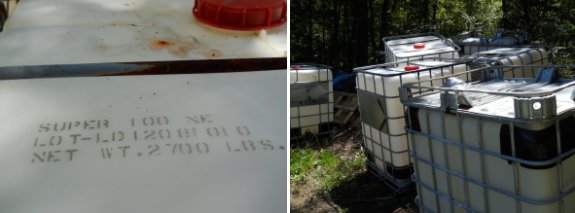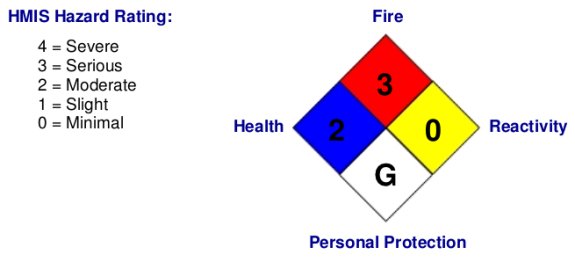
Identifying original contents of an Intermediate bulk container


Anna examined our new
intermediate bulk containers a bit more closely and discovered a
stencil printed on the top which describes the containers' original
content.
Super 100 NE contains only
two ingredients designated as hazardous. Isopropyl Alcohol and Glycol Ethers.
A quick google search reveals
that Super 100 NE has a strong smell. The plan is to give each tank a
smell test, and if we detect anything we'll keep rinsing it out till
the odor is gone.
I guess it would've been
smart to do this homework before I bought the things. I doubt if it
would have been worth it to mess with something chemically dangerous to
the point of being a "severe" health hazard.
Want more in-depth information? Browse through our books.
Or explore more posts by date or by subject.
About us: Anna Hess and Mark Hamilton spent over a decade living self-sufficiently in the mountains of Virginia before moving north to start over from scratch in the foothills of Ohio. They've experimented with permaculture, no-till gardening, trailersteading, home-based microbusinesses and much more, writing about their adventures in both blogs and books.
Want to be notified when new comments are posted on this page? Click on the RSS button after you add a comment to subscribe to the comment feed, or simply check the box beside "email replies to me" while writing your comment.

i am glad you are doing your home work on the pre-use of these. however for your money i believe you got a good find. i seen those and thought all kinds of uses. take 4 and make a sq. then wrap the plastic fence with a little extra work for gate and wa la you have an instance pasture for something. that strong metal can be cut with a saw all and make anything. strong suport for tomatoes.
grape vines . on and on. roseanell
If you look at the MSDS for the Super 100 NE, you'll only see two ingredients. But if you look closely at the percentages of those you'll see that they don't add up to 100%, not even close.
That is because an MSDS only lists those components that are designated as hazardous and are present is significant proportions. (What a significant proportion is depends on the nature of the substance, of course.)
All chemicals (excluding ultra-pure lab-grade stuff) generally contain a small fraction of other related chemicals. Generally when you let two or more substances react you'll get a range of related reaction products in different proportions depending on reaction parameters. Those parameters will generally be tuned so that one reaction product is prevalent, but that tuning cannot be perfect. See e.g. the production of isopropyl alcohol. These by-products are generally not named on an MSDS unless they're very hazardous.
I'm guessing that in this case most of the missing stuff is water since both of these chemicals are often used in aquaeous solutions, but there is no way to know for sure.
Rosenell --- The more I read about the tanks, the more potential uses I find for them. I think I've got more than seven uses for them in my head already....
Roland --- That's very good data. Sounds like we should do some more research of if we decide to use them for drinking water or anything else extremely heath-related.
Brenda --- Great idea! I'm not sure who made this set of containers, but some more sleuthing would probably turn that up.
Brian --- Mark and I were both wracking our brains to figure out how a surfactant/foaming agent would be used with wells. There are a lot of natural gas wells around here, so that makes a lot of sense.
When I worked in Biotech (Recombinant DNA Large scale bacterial culture for Pharmaceutical production) we used big tanks like these for our Glycerol..this was part of a food source for the culture...This gycerol was food grade and our tanks were triple rinsed before heading back to the chemical supplier to be refilled.
Once filled you needed a fork truck to move them, we also used dozens of smaller poly tanks in the 55 gal drum size. These were much easier to obtain and use for other things and could still be moved my hand with a hand truck.
I would be cautious about assuming that 100 NE was the only thing to live in those tanks since their manufacture. I've seen folks around here reuse those tanks and fill them with diesel, herbicides, pesticides, etc. Just because that's what was originally in there, doesn't mean that was the only thing. Unless they ever contained something extremely toxic, I would probably steam clean them and consider them clean enough for almost any use except maybe long term drinking water storage.
That said, I wish I could get a deal on some tanks like that. I have all kinds of uses for the things...
Moontree Ranch --- Interesting! I'm surprised to see how many of our readers have had first hand experience with these tanks.
Shannon --- Good point, especially since one of them was labeled "1993", so it's been in circulation for a while. A lot of people around here seem to use them to load up water from the river to give to their animals, but if we got unlucky, they could have used them for something much worse. I'm thinking of running a goldfish test --- filling the tanks up with water and throwing in some fish, then seeing if they survive.